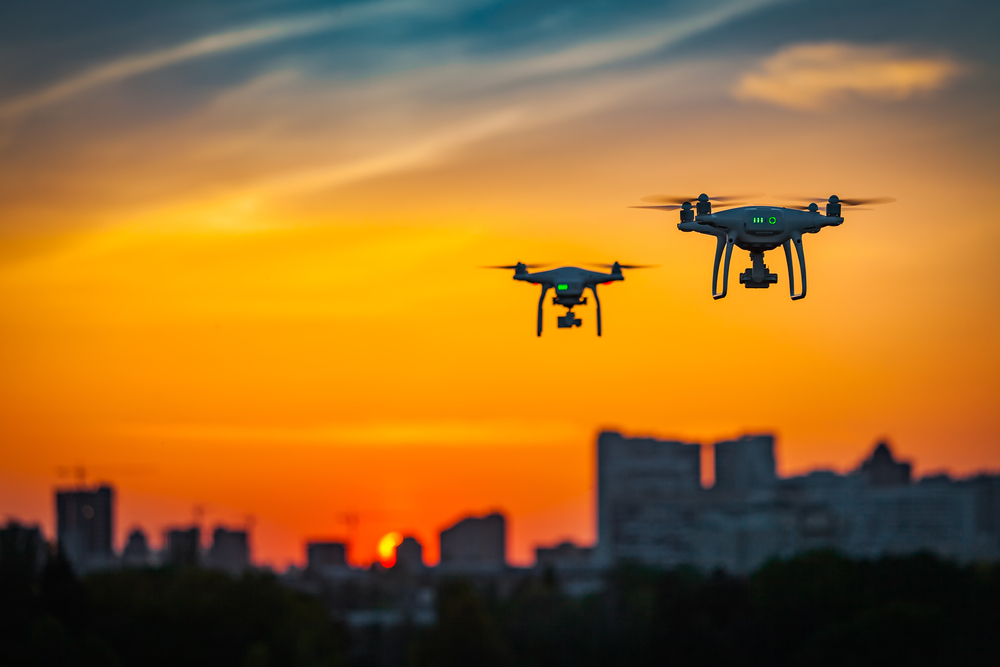Widespread commercial use of drones is poised to become commonplace in the coming years, such as Amazon’s introduction of fast airborne package delivery to homes and businesses, starting in 2024. This evolution will gather momentum as technological and regulatory hurdles are overcome, with successive adopters having a lower barrier to entry. From a lawful intelligence perspective, the proliferation of delivery drones in our near airspace may provide useful investigative data while also potentially reducing public attention to the drones themselves.
Unlike military drones, which are controlled using a secured dedicated global network, the first generation of civilian drone technology relied on peer-to-peer radio-frequency controllers. Those mechanisms limited the potential usages for the devices because of the short range and need for visual line-of-sight between the operator and drone. At the same time, the control path did not traverse public telecom networks, leaving it inaccessible to law enforcement via lawful interception techniques.
More advanced command and control for civilian drones is now available on 5G networks, which are explicitly designed to provide high throughput and low latency for the internet of things, including drones. This shift overcomes range and line-of-sight limitations, making drones viable as a tool for large-scale logistics. As more powerful drone technologies are developed and spread, criminal use is sure to follow, from harassment and voyeurism to smuggling drugs over borders and contraband into prisons. It’s also possible drones may be used for terrorism, such as delivering explosive payloads to destroy life and property.
Law Enforcement and Drones
Using 5G networks extends drones’ operation throughout the network coverage area, and the operator has a low-latency signal for real-time command and control that can be augmented by cameras and other sensors on the drone itself. This connection to the network is immensely powerful, allowing operation of drone fleets from anywhere in the world – including for nefarious activities. But transmitting the drone’s radio signal on a public 5G network means it must be equipped with a SIM card similar to a mobile phone, providing a potential target for lawful interception. In the UK, BT has launched a purpose-built SIM for drones, designed to support control, telemetry, and video streaming at altitude.
Lawful intelligence requirements and opportunities for drones may overlap with or differ from those of other 5G endpoints and devices. For example, location intelligence for drone targets must include the vertical z-axis (altitude) as well as the horizontal x-axis (longitude) and y-axis (latitude). The need for vertical location is needed in some other location intelligence scenarios, such as locating a subject on a specific floor of a building. Other mediation measures are more specific to drones and designed to counter the various types of public threats they present.
Beyond lawful interception of information, certain situations may call for the ability to interfere with the actual operation of the drone – for example, if law enforcement knew of a drone transferring a bomb to a densely populated area. In addition, geofencing would be a valuable tool, such as to identify when drones are operating in the vicinity of large special events or other areas of interest. Capabilities such as these would require collaboration among multiple parties, including standards bodies, equipment manufacturers, mobile network operators (MNOs), and other ecosystem participants.
Accommodating Drones for Lawful Intelligence
The rapid development of drone technology has outpaced the creation of lawful interception and intelligence regulations to govern it, but MNOs have incentive to be proactive in developing capabilities such as three-dimensional location services and geofencing for drones on their networks. Regulations are coming, and the early provision of technological assistance to law enforcement can be vital to protect public safety. It can also protect the MNO’s reputation by demonstrating responsible governance and good faith measures to prevent the use of their network in a terrorist event or organized crime.
Government regulators like the Federal Communications Commission (FCC) in the US and the Office of Communications (Ofcom) in the UK must move quickly to provide the tools that law enforcement will need to accommodate drones in their lawful intelligence practices. MNOs must be compelled to handover intercept related information from a drone when required by warrants or other legal authorization and offer the capability to identify its human operators at a given time.
International standards bodies such as 3GPP and ETSI must also take up lawful interception standards for drones and extend existing requirements to these devices as 5G endpoints. Interception of the command content being issued to a drone might be impossible because of encryption or other issues, so specifying the protocols and standards for intercepting information that illuminates how the drone is being used, such as metadata, will be vital. The time has arrived for the lawful intelligence industry to take its next steps regarding drone technology.
About Dr. Cemal Dikmen
As SS8’s CTO, Cemal plays an integral role in the company’s strategic direction, development, and future growth. A renowned expert and thought leader in the legal compliance and communications analysis domain, he has been a frequent speaker at various industry conferences over the past 10 years. Cemal holds BS, MS, and PhD degrees in Electrical Engineering. You can learn more about Cemal on his LinkedIn profile by clicking here.
About SS8 Networks
As a leader in Lawful and Location Intelligence, SS8 helps make societies safer. Our commitment is to extract, analyze, and visualize the critical intelligence that gives law enforcement, intelligence agencies, and emergency services the real-time insights that help save lives. Our high performance, flexible, and future-proof solutions also enable mobile network operators to achieve regulatory compliance with minimum disruption, time, and cost. SS8 is trusted by the largest government agencies, communications providers, and systems integrators globally.
Intellego® XT monitoring and data analytics portfolio is optimized for Law Enforcement Agencies to capture, analyze, and visualize complex data sets for real-time investigative intelligence.
LocationWise delivers the highest audited network location accuracy worldwide, providing active and passive location intelligence for emergency services, law enforcement, and mobile network operators.
Xcipio® mediation platform meets the demands of lawful intercept in any network type and provides the ability to transcode (convert) between lawful intercept handover versions and standard families.
To learn more, contact us at info@ss8.com.




